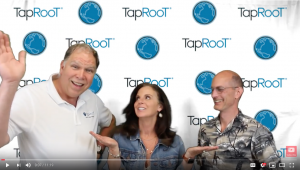Why Is Being Distracted (or Rushed) a Risk?

70 Percent of Workers Admit to Being Distracted on the Job . . .
You read it right: On the job, 70 percent of workers are distracted. Do we ever set out to intentionally ignore the core principles of safety? Hopefully, not. However, when we feel distracted from our current task, it’s easy to overlook core safety principles. Why? Because our focus has shifted to taking care of something “really quick” so that we can “get back to the task/meeting/thing we have to do.”
Human Error Has Been Identified as the Top Cause of Accidents
When we lose focus on the task at hand, depending on the job and function, it’s possible for us to unwittingly in the process create a hazard for those around us. That’s a large part of why, in the workplace, being rushed (or distracted) is a risk. The time factor imposes pressure, opening up a setup for mistakes. The sooner we openly acknowledge that pressure creates the opportunity for mistakes to be made, the sooner our sensitivity is heightened, alerting us that we’re performing under compromised safety.[1]
Unfortunately, for many workers, distraction is the norm, and there’s a reluctance in the collective work culture to discuss it.
It Could Have Been Worse: A Near-Miss that Underscores a Lack of Mindfulness in the Workplace
A near-miss recently occurred in the Energy Systems Integration Facility of the Office of Energy Efficiency & Renewable Energy, at NREL (a national laboratory of the U.S. Department of Energy). A researcher left a material capable of melting laying on a conductive table. Fortunately, the event did not materialize into something more serious, but it poses a few points worth emphasizing and adapting into practice.
Cutting-edge Science Requires Cutting-edge Safety
The researcher was running late for a meeting. He wanted to be proactive; he wanted his experiment ready to go when he returned from the meeting. The researcher set up the experiment he had performed many times, then headed out to his meeting. Prior to leaving, however, he operated In a rushed fashion by:
- setting up the experiment out of sequence;
- failing to double-check that everything was running properly;
- creating an electrical hazard that could have been fatal.
The researcher returned to a burning smell in the lab, alerting him to something having gone wrong. Had a less experienced person come into the lab first, the potential for identifying the danger might have been overlooked.
What Was Discovered During the Evaluation?
- An inexpensive silica mat could have been purchased and placed on the table, eliminating conductivity.
- Grounded junction boxes eliminated the risk of fatal shock.
- When the researcher was interviewed, he kept using the words “rushed” and “running late.” While the researcher expressed that prior to leaving he sensed that “something didn’t seem right,” he left the active experiment and exited the lab in a rush to get to the meeting.

Recommendation: Foster a Work Culture that Encourages a Questioning Attitude
We should develop a healthy respect for what can go wrong with each activity we perform. In doing so, we take personal responsibility for safe operations. Additionally, we should take a minute to identify the hazards for every task, every time. By encouraging a questioning attitude and understanding that learning never stops, we allow for leaders to pass along the safety legacy and for staff to feel comfortable while raising safety concerns.
How Can You Optimize Workplace Mindfulness and Minimize Risks of Distractions and Hazards?
Pharmacists have to be on-task every minute of their shifts. Yet, they get interrupted about every two minutes. The American Pharmacists Association has published “Deflect distractions and intercept interruptions” to help healthcare professionals navigate multitasking, distractions, and interruptions that have become the norm in their work environment.
You don’t have to be a mindfulness expert to improve your ability to stay focused on the task and avoid serious mistakes. These few simple behavioral changes can help:
- Focus on your breathing to help you stay in the moment.
- Take occasional brief breaks and let your mind deliberately wander, then return to the task more focused. A tweak on the occasional brief break for larger organizations is to have official break times, giving workers the opportunity to switch off from focused tasks.
- Stay well-fed and well-hydrated so that thirst and hunger don’t distract you.
- Write down thoughts about things you need to remember to do at home. This gets them out of your head and helps you concentrate on the task.
- Create a work environment that helps you concentrate. For example, you might position yourself to get more daylight or get away from noisy coworkers.
- Be mindful of the risks of repetitive work. Focus can lag when workers do the same thing over and over again. Consider job rotation to avoid the risk. Brainstorm with your peers or manager to identify clear risks (causal factors). Pinpoint solutions (corrective actions) for situations that occur as a reaction to distractions.
- Avoid multi-tasking and manage one job at a time to stay focused.
- Put your mobile phone on silent (no buzzing either) or stow away so it’s not a distraction.
- Stretch and move during lengthy endeavors of any type — shifts, conference calls, etc.
Incorporate These Hands-on Practices to Help Build, Renew, and Maintain Sharp Focus
- To expand upon taking a break: Move away from where you are; make a deliberate visual change from your usual workspace environment—a physical and visual break.
- Make it your focus to rest well when you are away from work, and arise feeling refreshed.
- If your job is endlessly repetitive, brainstorm solutions with your manager.
- Compare notes with other workers to learn about their coping mechanisms.
Source content credit: Some content in this lesson learned is taken from OPEXSHARE, “Mindfulness in the Workplace,” the Environment, Safety, Health, & Quality Office, NREL.
Photo source/credit: Featured image:Image by Elisa from Pixabay.

Listen to the Latest TapRooT® TV Video Series and Podcasts
View or listen to a discussion by TapRooT® professionals. Check out new TapRooT® videos on Facebook (click here to watch on Facebook), or YouTube (click here to watch on YouTube). You may also listen to TapRooT® on the go via our Podcast channel; find our channel on iTunes and Stitcher.
A topical TapRooT® TV series you may be interested in is the “How to Stop Human Error Video Series.” For a reduction in the number of mistakes your workers make, you need human factors solutions that prevent the opportunity for your workers to make errors.
The TapRooT® System trains you to solve problems
Circumstances can crop up in any occupation at any time if proper and safe sequence and procedures are not planned and followed. We encourage you to learn and use the TapRooT® System to solve problems.
TapRooT® has a team of investigators and instructors with years of extensive training ready to offer assistance worldwide. We also offer ongoing support to our clients through Free Newsletters and Root Cause Tip Videos, the Root Cause Analysis Blog, and our annual Global TapRooT® Summit.

Register for a TapRooT® Course
Register for one of our TapRooT® Root Cause Analysis Training courses. We offer a basic 2-Day course and an advanced 5-Day course. Contact US or call 865.539.2139 about having a course at your site or for further root cause analysis training opportunities. We’re here to find solutions for you.



